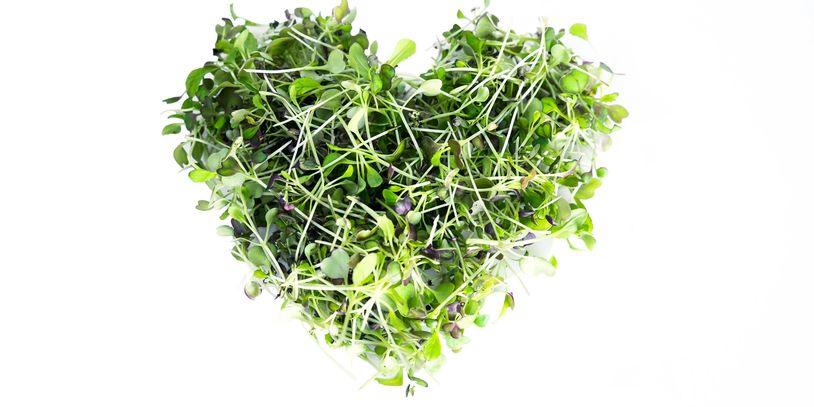Broccoli

Nutritional Value & Density
Broccoli microgreens are one of the most nutrient-dense microgreens, containing up to 40 times more sulforaphane than mature broccoli. Sulforaphane is a powerful compound known for its anti-inflammatory and detoxifying properties.
Vitamins & Minerals
- High in: Sulforaphane, Vitamin C, Vitamin A, Vitamin K, Calcium, Iron
- Antioxidants: Glucosinolates, flavonoids, and carotenoids
Health Benefits
- May help prevent cancer by activating detoxification enzymes in the body
- Reduces inflammation, which is linked to arthritis and other chronic conditions
- Supports heart health by reducing oxidative stress
- Boosts immunity and protects against infections
Flavor, Taste & Texture
- Flavor: Mild, slightly peppery, with a hint of cabbage-like freshness
- Texture: Soft yet slightly crunchy, tender and juicy
How to Use
- Blended into green smoothies for a nutrient boost
- Added to omelets, scrambled eggs, or avocado toast
- Mixed into salads or grain bowls for crunch and flavor
- Used as a topping for soups, sandwiches, or tacos
Radish

Nutritional Value & Density
Radish microgreens contain up to 4 times more vitamin C than mature radishes and are rich in antioxidants that promote detoxification and digestion.
Vitamins & Minerals
- High in: Vitamin C, Vitamin E, Potassium, Folate, Calcium
- Contains: Anthocyanins and polyphenols for anti-inflammatory benefits
Health Benefits
- Boosts immunity and fights colds with high vitamin C levels
- Aids digestion by promoting gut health
- Reduces oxidative stress, helping to prevent heart disease
- May support weight loss due to fiber content and metabolism-boosting properties
Flavor, Taste & Texture
- Flavor: Spicy, peppery, and zesty, similar to mature radishes
- Texture: Crisp, crunchy, and refreshing
How to Use
- Sprinkled over rice bowls, tacos, or burgers for a peppery crunch
- Blended into fresh vegetable juices or spicy smoothies
- Tossed into stir-fries or grain salads
- Used as a garnish for sushi, soups, and sandwiches
Pea

Nutritional Value & Density
Pea microgreens are packed with up to 7 times more vitamin C and 8 times more folate than mature peas, making them an excellent source of plant-based nutrition.
Vitamins & Minerals
- High in: Vitamin C, Vitamin A, Vitamin K, Folate, Iron, Magnesium
- Rich in: Plant-based protein and chlorophyll
Health Benefits
- Supports bone health with high levels of vitamin K
- Boosts red blood cell production, reducing the risk of anemia
- Improves digestion with its fiber and prebiotic content
- Aids muscle growth and repair due to high protein levels
Flavor, Taste & Texture
- Flavor: Sweet, fresh, and slightly earthy, like sugar snap peas
- Texture: Crisp, tender, and slightly chewy
How to Use
- Blended into smoothies for a mild, sweet taste
- Tossed into pasta dishes or grain bowls
- Stirred into soups or sautéed with garlic and olive oil
- Used as a base for fresh wraps or sandwich fillings
Sunflower

Nutritional Value & Density
Sunflower microgreens contain up to 5 times more vitamin E than fully grown sunflowers, making them one of the best sources of this essential antioxidant.
Vitamins & Minerals
- High in: Vitamin E, Vitamin B6, Zinc, Magnesium, Iron
- Rich in: Healthy fats and amino acids
Health Benefits
- Supports healthy skin and hair with high vitamin E levels
- Boosts immune function with zinc and magnesium
- Aids in muscle recovery and energy production
- Promotes heart health by reducing bad cholesterol levels
Flavor, Taste & Texture
- Flavor: Nutty, slightly sweet, and mild, similar to sunflower seeds
- Texture: Crunchy, hearty, and slightly juicy
How to Use
- Added to smoothies or protein shakes for a mild, nutty flavor
- Sprinkled over grain bowls, stir-fries, or scrambled eggs
- Used in fresh wraps, sandwiches, or veggie burgers
- Blended into pesto or hummus for extra creaminess
This website uses cookies.
We use cookies to analyze website traffic and optimize your website experience. By accepting our use of cookies, your data will be aggregated with all other user data.